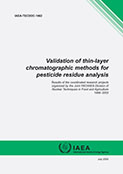Validation of Thin-Layer Chromatographic Methods for Pesticide Residue Analysis
IAEA-TECDOC-1462
ISBN
92-0-108205-3
236 pages | € 15.00 | Date published: 2005
Thin-layer chromatography (TLC) was widely used in the 1960s and 1970s for pesticide residue analysis, but only to a limited extent since gas–liquid chromatography (GLC) and high performance liquid chromatography (HPLC) have become readily available. In recent years, there have been various developments in the quality of plate coating and in detection systems, as well as in extraction and cleanup methods, that make it possible to apply TLC according to the current international quality standards. The TLC methods described in this publication are intended for laboratories where irregular supply of electricity, lack of service or limited budget do not allow continuous use of GLC and HPLC techniques, and where application of mass spectrometric detection is not feasible. TLC analytical techniques allow for screening, semi-quantitative determination and confirmation of pesticide residues and other organic trace contaminants, and have only minor requirements on equipment and laboratory infrastructure. TLC methods are therefore particularly suitable for laboratories working on limited budgetary resources.
Thin layer chromatography (TLC) was widely used in the 1960s and 1970s for pesticide residue analysis, but only to a limited extent since gas-liquid chromatography (GLC) and high performance liquid chromatography (HPLC) have become readily available. In recent years, there have been various developments in the quality of plate coating and in detection systems, as well as in extraction and cleanup methods, that make it possible to apply TLC according to the current international quality standards. The TLC methods described in this publication are intended for laboratories where irregular supply of electricity, lack of service or limited budget do not allow continuous use of GLC and HPLC techniques, and where application of mass spectrometric detection is not feasible. TLC analytical techniques allow for screening, semi-quantitative determination and confirmation of pesticide residues and other organic trace contaminants and have only minor requirements on equipment and laboratory infrastructure. TLC methods are therefore particularly suitable for laboratories working on limited budgetary resources.
